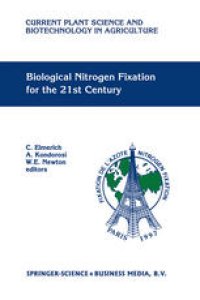
Ebook: Biological Nitrogen Fixation for the 21st Century: Proceedings of the 11th International Congress on Nitrogen Fixation, Institut Pasteur, Paris, France, July 20–25, 1997
- Tags: Plant Sciences, Plant Physiology
- Series: Current Plant Science and Biotechnology in Agriculture 31
- Year: 1998
- Publisher: Springer Netherlands
- Edition: 1
- Language: English
- pdf
Nitrogen availability is one of the most critical factors that limits plant productivity. The largest reservoir of nitrogen is the atmosphere, but this gaseous molecular nitrogen only becomes available to plants through the biological nitrogen fixation process, which only prokaryotic cells have developed. The discovery that microbes were providing fixed nitrogen to legumes and the isolation of the first nitrogen-fixing bacteria occured at the end the 19th Century, in Louis Pasteur's time. We are now building on more than 100 years of research in this field and looking towards the 21st Century. The International Nitrogen Fixation Congress series Started more than 20 years ago. The format of this Congress is designed to gather scientists from very diverse origins, backgrounds, interests and scientific approaches and is a forum where fundamental knowledge is discussed alongside applied research. This confluence of perspectives is, we believe, extremely beneficial in raising new ideas, questions and concepts.
The refinement of molecular techniques and the development of new probes of the phylogeny of diazotrophs has revealed an extreme biodiversity among the nitrogen fixers, which helps explain the role that nitrogen fixation plays in maintaining life on Earth. The most efficient ecosystems are those where the bacteria are associated with a plant in differentiated organs to benefit crop productivity. Most short-term benefit from fundamental research on nitrogen fixation is likely to result in the improvement of existing nitrogen-fixing symbiotic or associative systems. Longer-term efforts are aimed at extending the nitrogen-fixing capacity to other organisms, including transfer of the genetic information for efficient nitrogen fixation into the plant genome and using current knowledge of microbe-plant interactions to extend symbiosis to cereals and, in particular, to rice. Related challenges in sustainable agriculture and forestry include the creation of new nitrogen-fixing associations. All of these approaches were discussed at the 11th International Congress on Nitrogen Fixation, Paris, France, July 20-25, 1997 and covered in the present proceedings volume.